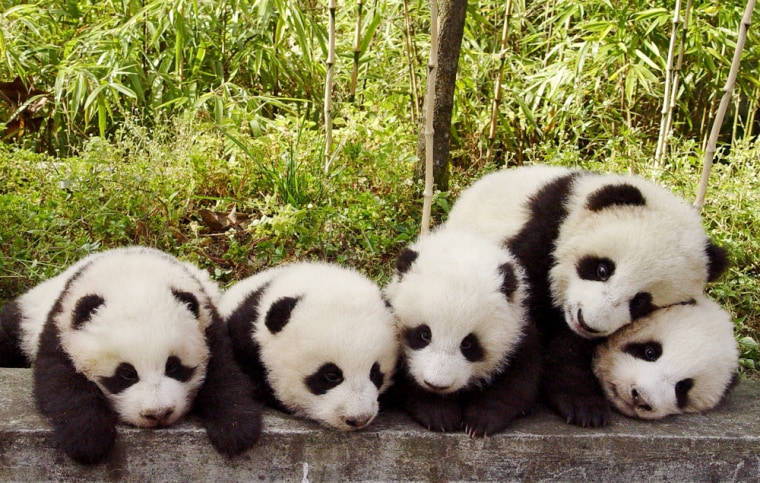Chinese scientists have logged a record number of giant panda births in captivity this year through improved artificial insemination techniques and better understanding of how the reclusive but universally appealing creature lives and mates.
The result of hard science by no-nonsense researchers, the increased birthrate is good news for the many children and soft-hearted adults around the world who delight in the sight of pandas, with their distinctive black and white fur, sitting back and tranquilly munching on bamboo leaves.
The pandas slouching about their compound here at the Chengdu Giant Panda Breeding Research Base in central China's Sichuan province did not seem particularly moved by their species' accomplishment. But at least 19 pandas were born — and have survived — this season in a pair of Chinese research facilities, officials said, the highest number since scientists here and abroad began trying to foster reproduction of the endangered animal through artificial insemination about 40 years ago.
Several more were born in research centers and zoos in other countries, including twin cubs born Aug. 23 in the Adventure World Park Zoo in western Japan's Wakayama prefecture, of which only the female lived, and Tai Shan, a male cub who was born at Washington's National Zoo on July 9 and is reported to be thriving. In all, up to 25 giant pandas were born and survived in captivity around the world during this summer's birthing season, according to the State Forestry Administration and Chinese specialists.
A survey last year by the State Forestry Administration showed that the number of giant pandas living in the wild has also risen, to an estimated 1,590, up from 1,110 in the 1980s. Most roam the isolated hills of China's Sichuan, Gansu and Shaanxi provinces, eating bamboo and staying as far as they can from human beings. The population has grown over the last several years, scientists said, because the government has turned large parts of the panda's habitat into reserves where logging and farming are forbidden.
This marks a turnaround from the years when China's ever-expanding human population intruded on the hillsides where giant pandas live and breed, turning them into an endangered species. The panda, whose markings and chubby contours seem to invite cuddling, in fact is easily distressed by contact with human beings, research has shown, and it seems to thrive best when left alone among the bamboo stands of central China's misty mountains.
Partly for that reason, scientists for years have had trouble getting captive giant pandas to reproduce. With a limited number of males to choose from in captivity, picky females often resisted advances, they found, and males in contact with humans at zoos and research institutes seldom seemed to show much ardor. Fewer than a third of captive pandas have mated naturally.
As a result, intensive efforts have been under way since the 1960s to breed pandas by artificial insemination. As techniques and knowledge improve, the artificial route has begun to show better results, particularly since the turn of the century.
The Chengdu facility's director, Zhang Zhihe, held out the promise of repeating and perhaps improving on this year's productive season in coming years. "Gradually, from year to year, we have begun to know more about giant pandas, their genetic makeup, their habits, their nutrition and so on," he said in an interview. "And the more we know about them, the more we can help them reproduce."
Three of this year's births in China took place at Zhang's institute, which houses 48 pandas in a series of compounds strewn with bamboo stalks and built to resemble the hillsides where pandas live naturally. Sixteen other births, including two instances of twins, occurred at the Wolong Giant Panda Breeding and Research Center, a sister institute 80 miles northwest of Chengdu and nearer to the panda's natural habitat.
The biggest reason for this year's record and the hope of more high numbers in the future, Zhang said, is that a growing number of captive pandas are reaching mating age, 5 years old for females and 6 or 7 for males.
The broader the circle of possible suitors for each female, the higher the chances that she will accept a male for natural fecundation, said Zhang, a veterinarian and geneticist by training. And if artificial insemination is still necessary, as is likely, he added, the wider selection of males will mean a wider gene pool and stronger animals with a higher survival rate.
The goal, Zhang added, is to reach a point where the captive pandas reproduce naturally and become numerous and strong enough that they can be released into the wild. "But we still have a long way to go," he said, "because if we want to have a self-sustaining panda population, we need a bigger pool of individuals, because we need a relatively high genetic diversity."
A key step came in 1980, when scientists learned how to preserve the male's sperm by freezing it in liquid hydrogen. Since then, he said, they have little by little learned how to understand when the female is ready to conceive, a period of only a few days each year. The prospective mother emits a distinctive sound when she is ready, he added, and her sexual organs change color, turning red then white.
If conception occurs, baby pandas remain in gestation for 160 days, after which one or two cubs are born.
